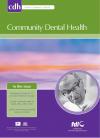Community Dental Health

- Cover Date:
- June 2008
- Print ISSN:
- 0265 539X
- Vol:
- 25
- Issue:
- 2
Editotial - Do we let children’s teeth decay just because some people object to topping up the natural fluoride that’s already in our water?
Tooth decay rates among children have been falling in most European countries since the mid-1970s, with the gap between the countries with the highest and lowest average levels narrowing. Widespread use of fluoride toothpaste, high levels of educational achievement in the Scandinavian countries, and public health approaches such as the use of fluoridated salt in Switzerland, France and Germany, have all contributed to this welcome improvement. Whilst average tooth decay rates are down, those averages mask stubbornly high decay rates in some communities and in some social groups. Many young children in the UK still suffer from severe dental caries (BASCD, 2007). No one in public health could reasonably argue that dental caries in the UK is a battle already won. It is not. Even if we take the deceptively soothing average dmft scores (decayed, missing or filled teeth), we find a fivefold difference between the best and worst dental health. The average South Staffordshire five year old has 0.6 dmf teeth (the best dental health in England), while the average Blackburn five year old has 3.2 dmf teeth (the worst in England) (BASCD, 2007).
- Article Price
- £15.00
- Institution Article Price
- £
- Page Start
- 66
- Page End
- 69
- Authors
- M.A. Lennon, J.F. Beal, A.J. Rugg-Gunn
Articles from this issue
- Title
- Pg. Start
- Pg. End
- Editotial - Do we let children’s teeth decay just because some people object to topping up the natural fluoride that’s already in our water?
- 66
- 69
- Dental caries rates in primary teeth in 2002, and caries surveillance trends 1981-2002, in a South African city.
- 79
- 83
- Individual and maternal determinants of self–reported dental health among Turkish school children aged 10-12 years.
- 84
- 88
- Comparison of ranking dental status using the Significant Caries Index and the Significant Filled and Sound-Teeth Index
- 103
- 106
- Measuring oral health behaviour in Flemish health care workers: an application of the Theory of Planned Behaviour
- 107
- 114
